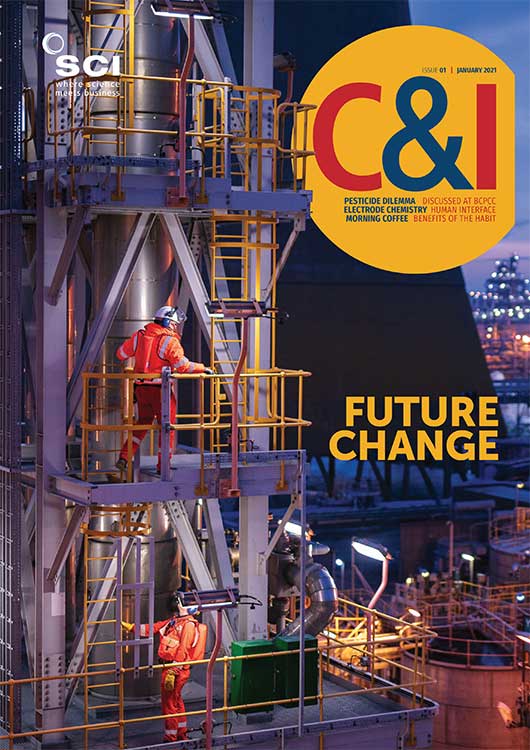Neil Eisberg, Editor
As the world said farewell, and good riddance, to 2020 and the New Year was given a subdued and cautious welcome, there was a rash of events involving chemistry, apart from the final closure of the Brexit saga.
For the UK, the end of the Brexit transition period was dominated by the question of whether a trade agreement would be reached – as many expected, the whole negotiation process was dragged out to the very last moment. But an agreement was signed off by both parties, so that on 1 January 2021, UK Reach came into existence.
According to the UK Chemical Industries Association (CIA), however, UK REACH is likely to cost UK chemical companies of the order of £1bn to duplicate the research that has already been carried out for EU REACH, a task that may take years.
Even before the Brexit negotiations were completed, the UK chemical industry was still reasonably optimistic about its future prospects. In the mid-November quarterly survey released by the CIA, it was reported that 57% of chemical companies surveyed expected to see sales and exports continuing to grow during the final quarter of 2020, and perhaps more importantly, into 2021.
Commenting on the UK-EU trade deal, Marco Mensink, Director General of the European Chemical Industry Council (Cefic), said: ‘We shouldn’t underestimate the huge value that this deal brings in terms of certainty for companies to operate in. Certainty that was most needed.’
The predicted log-jam of cross-Channel traffic has so far failed to materialise, although in the run up to the Christmas period, French reaction to the UK’s Covid resurgence did put the proposed post-Brexit commercial traffic arrangements to the test. Stockpiling has been given as one reason for the lack of congestion in January.
Obviously the major event of 2020 was the Covid-19 pandemic, with its unprecedented impact on society and economies around the globe. However, over the period between C&I issues, three Covid vaccines, from Pfizer/BioNTech, Moderna and Oxford University/AstraZeneca, have been approved for use in the UK, which has taken a world lead in its vaccination programme. The UK has also demonstrated itself to be a world leader in the development of vaccines – not only in terms of the scientific expertise that has been demonstrated but also in the not-for-profit approach adopted by Oxford University and AstraZeneca.
There has been concern about how the initially limited supplies of vaccines have been allocated, and also why vaccines deliveries appear to have been slow. Some observers cited a shortage of vials – something denied by both vaccine producers and their suppliers. However, vial suppliers, such as Bormioli in Italy and Becton Dickinson in the US, have announced increasing their capacities to meet what is a global demand, the like of which has never been seen before.
Vaccine producers have also pointed out that there are many steps between production of a vaccine in bulk and its delivery to patients, including fill and finish, quality control checks and approvals. Different vaccines also present different logistics issues in moving from manufacturer to patient, with the Oxford/AstraZeneca product offering the advantage that it can be stored in standard freezers.
In global terms, perhaps the most thought-provoking event has been the Chinese authorities refusing admittance, despite previous agreement, of the WHO investigation team tasked with discovering the origin of the pandemic. Discussions are still continuing as C&I goes to press, but it would appear this is a very sensitive issue for China, which has also been accused of covering up the growth and impact of the pandemic.
The pandemic and consequent vaccine developments have somewhat overshadowed developments in other areas such as energy. The push to replace conventionally fossil-fuel powered transport with electric vehicles has continued apace. But electric vehicles come in two forms, requiring batteries or fuel cells usually driven by hydrogen.
The UK Chemistry Council has pushed for the UK government to support both approaches in its industry Sector Plan. It was therefore heartening to see the December announcement of the UK’s first so-called Gigafactory to produce automotive Li-ion battery packs, a £2.6bn facility to be built by Britishvolt on the site of an old power station at Blyth on the Northumberland coast, with production beginning by the end of 2023.
While hydrogen fuel cells have drifted in and out of favour in recent years, the replacement of natural gas for domestic heating and cooking has recently seen more encouragement. In December 2020, it was announced that 300 homes in the Levenmouth area of Fife in Scotland are to be converted, without charge, to so-called green hydrogen in a £28m trial funded by the energy regulator Ofgem and the Scottish government. This project is believed to be the first of its kind in the world, with the hydrogen generated using an existing wind turbine.





